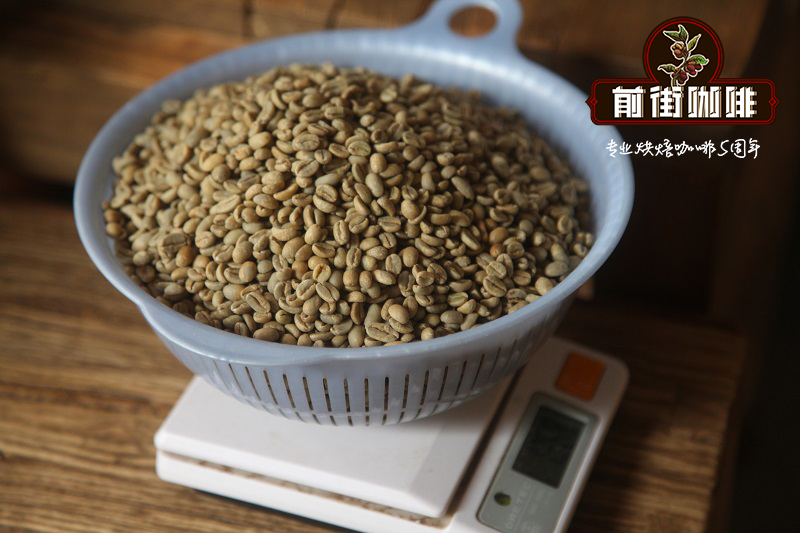What are the picking methods of coffee beans? Is manual picking better for the quality of coffee beans?

Professional coffee knowledge exchange more coffee bean information please follow the coffee workshop (Wechat official account cafe_style)
What are the picking methods of coffee beans? Is manual picking better for the quality of coffee beans?
There are three main ways to harvest coffee beans:
1. Stripping: peel off the ripe (red) and unripe (green) coffee fruits on the branches and peel them all at once. This method of harvesting is fast, but it is only suitable for areas where the climate is dry, because after every heavy rain, a batch of coffee fruits ripen. In some large farms in Brazil, there are artificial sprinkler systems that can control the ripening time of coffee fruits without listening to the sky. When a large number of coffee fruits on the tree turn red, they can be quickly collected by string peeling, and then the light, immature beans are removed by a floating water test.
two。 Manual picking (Hand Picking): for example, in Vietnam or Laos, there are several heavy rains during the rainy season, each time it will blossom after a rain, and then bear fruit, so the coffee fruit will mature in different stages, even on the same branch, there will be red (ripe) and green (immature) fruit at the same time, mature fruit can not stay on the tree for too long, because bad will turn black and become rotten beans. Therefore, it is impossible to use the method of string peeling, so the grains must be picked by hand, and only the red ones must be picked.
Areas that pay attention to quality will insist on picking by hand, and harvesting workers will selectively pick coffee fruits that are ripe with reddish and dark red peels, leaving immature fruits to be picked after ripening. As long as you pick the ripe coffee fruit (red or close to red) during harvest. Squeeze the ripe fruit with your fingers, and if the coffee beans slip out, it means it is ripe and can be picked. The picking of each batch should be completed within two weeks (that is, each picking cycle is within two weeks). After harvest, pick out the immature, overripe and withered fruit. At the last harvest of the harvest season, all the fruit left on the tree should be removed so that the fruiting branches are ready for the next flowering season.
In Brazil, most coffee plantations harvest only once a year, regardless of ripe, immature or overripe fruit, all swept to the ground at one time during the harvest period (this method of harvest is called strip brush-off harvest, which brushes off the coffee fruit at once). The fruit falls into the plastic cloth spread on the ground, and the fruit is collected into piles. Use a sieve or wind drum to sift out stones and soil, along with miscellaneous branches, leaves and all sundries mixed during harvest, and then send the fruit to the bean drying farm for exposure. The fruit is usually dumped in the bean drying farm according to the harvest order and dried separately. The sun exposure is divided by date.
In the major coffee-producing countries, the use of machine harvesting can reduce the cost of harvesting in relatively flat and large-scale farms. The problem is that when harvested by machines, the dried fruits that are ripe, immature, and overripe are harvested all at once. The quality is inferior. In order to improve the quality, the unqualified fruit and sundries must be screened out and discarded by the coffee fruit rinsing classifier after harvest.
Which method of harvesting coffee is suitable for growing coffee in Taiwan, whether it is picked by hand, brushed off at once, or harvested by machine? The labor cost of manual picking is high, and the harvest speed is slow; although the labor cost of one-time brush-off is relatively low, it will reduce the quality of coffee beans. The machine harvests the fastest, but the quality is the worst. And the equipment cost of the coffee harvester is very high, so it is only suitable for large-scale coffee plantations in gentle areas. At present, one of the main reasons why coffee acreage is not common in Taiwan is that farmers calculate that the cost of collecting wages in coffee plantations is too high. I would like to say that if there were more convenient ways like machine harvesting, more people would join the ranks of coffee growers. They do not realize that machine harvesting is impossible to produce high-quality coffee. In order to produce high-quality Taiwanese coffee, of course, it has to be picked by hand.
3. Machine harvesting (Mechanical Harvesting): large farms in Australia and Brazil use large self-propelled machines to harvest cherries from branches and put them in bags or trucks. It is generally believed that high-quality coffee can only be obtained by picking by hand. For a small coffee farmer, yes. However, for a modern medium to large farm, high-quality coffee beans can also be obtained by using different harvesting methods. Why? As mentioned before, only freshly ripe coffee beans without defects can become high-quality coffee beans. If the late screening and separation techniques are done well, no matter how they are picked, only fresh and mature coffee beans can be retained to become high-quality coffee.
The flowers fade and produce turquoise coffee fruit, which ripens for six to eight months. The color of the exocarp of coffee fruit gradually turns red, and the color changes from light red to dark red, and then to dark red. When the color of coffee pericarp changes to crimson and dark red, it has the best maturity and is the best time to harvest. If it is not harvested at the right time, the color of the coffee fruit will slowly turn dark black, and finally become withered and wrinkled. Due to the high sugar content of coffee fruit, when the fruit becomes withered and wrinkled, it is easy to be infected by mold, which affects the quality of the whole batch of coffee beans.
According to the principle of producing high-quality coffee, the most important factor is to pick the ripe coffee fruit. Only the ripe fruit has good coffee. There can be no way to improve the quality after harvest. Some people think that processing can be used to improve quality, but in fact, this is wrong. It is also impossible to improve the quality by baking. There is a plausible saying in the market that the quality of a cup of coffee is due to the master's skill in roasting or brewing. In fact, the main factors affecting the quality of a cup of coffee are coffee garden management technology, post-harvest processing technology, and finally baking technology and brewing technology. The first two items are the basic elements of the quality of shadow coffee. Roasting and brewing just show the quality of coffee.
The quality of coffee beans has been determined on the coffee tree, and producers must always focus on the coffee tree to produce the best quality fruit. This result can only be achieved by taking good care of it. A single harvest alone cannot improve quality by any currently known processing method. However, after harvest, there are many opportunities to corrupt coffee beans and reduce the quality of coffee beans. One of the mysteries of producing high-quality coffee is that the coffee should be processed as soon as possible after harvest, and the process should be kept clean to avoid the deterioration of coffee beans.
Another reason for speeding up the coffee processing process is that coffee beans will actually lose weight due to certain factors. After the coffee is harvested, it is quickly affected by some metabolism, which breaks down the sugar in the coffee beans into carbon dioxide and disappears in the atmosphere. This process continues until the coffee beans are "suppressed" or dried to a certain extent.
According to various research reports, the weight loss rate is the highest in the fermentation process, which will lose 3-4% of the weight of raw beans.
If the coffee can be processed within 24 to 36 hours after harvest, compared with stacking for a few days, 6% of the weight can be saved.
Remember: harvest only ripe fruits during the fully ripe period, and carry out and complete the follow-up treatment as quickly as possible.
There are three main processing methods of coffee beans: solarization, water washing and semi-washing. The treatment process of the sun method is that after the fruit is harvested, it is spread directly in the bean drying farm until it is dried. The whole process of washing method includes: fruit harvesting, preliminary screening of sundries and inferior fruits, peeling, fermentation, washing, sun drying or machine drying, bagging storage, shelling, screening and grading. The process of semi-washing method is as follows: fruit harvest, preliminary screening and picking up sundries and inferior fruits, peeling, sun drying, bagging storage, shelling, screening and grading. The actual operation flow of the above three processing methods is different. The whole process of washing and semi-washing takes about 7 to 10 working days, and the sun rule takes more than 3 weeks to make coffee beans reach the standard water content of 12%.
Important Notice :
前街咖啡 FrontStreet Coffee has moved to new addredd:
FrontStreet Coffee Address: 315,Donghua East Road,GuangZhou
Tel:020 38364473
- Prev

Introduction to the flavor and taste characteristics of the grade varieties of golden Manning coffee
Professional coffee knowledge exchange more coffee bean information Please follow the coffee workshop (Wechat official account cafe_style) yesterday, a fan came to communicate with us, why there are so many names for Manning on the market? Manning really has a lot of names on the market, Golden Manning and Dingshang Golden Mante.
- Next

Indonesian Tiger Mantenin | unique treatment-Why use wet planing?
Professional coffee knowledge exchange more coffee bean information please follow the coffee workshop (Wechat official account cafe_style) Ache Sumatra Tiger Mandheling Aceh Sumatran tiger Mantenin producing area: Aceh varieties: Caturra, Typica, Sidikalong soil: volcanic soil altitude: 1500m treatment method: wet planing method 01 | production area introduction Indonesia is a group
Related
- Detailed explanation of Jadeite planting Land in Panamanian Jadeite Manor introduction to the grading system of Jadeite competitive bidding, Red bid, Green bid and Rose Summer
- Story of Coffee planting in Brenka region of Costa Rica Stonehenge Manor anaerobic heavy honey treatment of flavor mouth
- What's on the barrel of Blue Mountain Coffee beans?
- Can American coffee also pull flowers? How to use hot American style to pull out a good-looking pattern?
- Can you make a cold extract with coffee beans? What is the right proportion for cold-extracted coffee formula?
- Indonesian PWN Gold Mandrine Coffee Origin Features Flavor How to Chong? Mandolin coffee is American.
- A brief introduction to the flavor characteristics of Brazilian yellow bourbon coffee beans
- What is the effect of different water quality on the flavor of cold-extracted coffee? What kind of water is best for brewing coffee?
- Why do you think of Rose Summer whenever you mention Panamanian coffee?
- Introduction to the characteristics of authentic blue mountain coffee bean producing areas? What is the CIB Coffee Authority in Jamaica?

